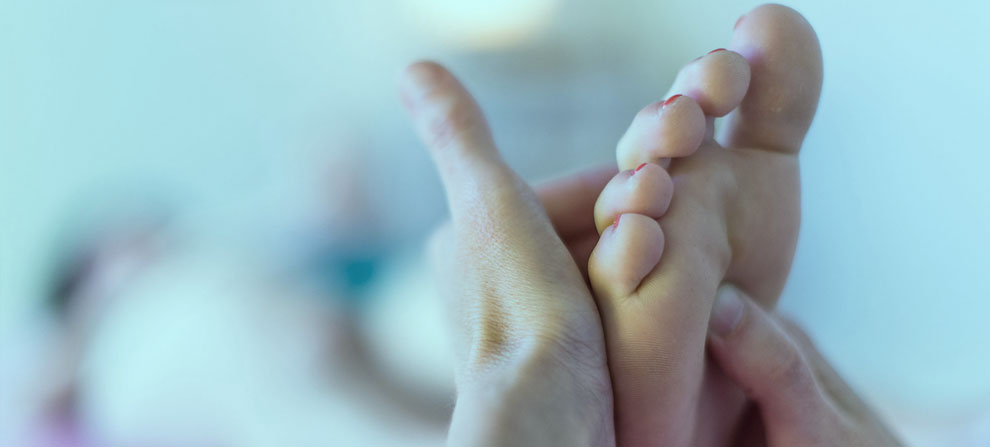Therapeutic Reflexology

A relaxing complementary healing practice that can be integrated into your
current medical care or your ongoing wellness program.

A relaxing complementary healing practice that can be integrated into your
current medical care or your ongoing wellness program.
The Reflexology Association of America (RAA) defines Reflexology as a protocol of manual techniques, such as thumb and finger-walking, hook and backup and rotating-on-a-point, applied to specific reflex areas predominantly on the feet and hands. These techniques stimulate the complex neural pathways linking body systems, supporting the body’s efforts to function optimally.
Reflexology sessions are given fully clothed on a massage table or in a zero-gravity reclining chair.

The Reflexology Association of America (RAA) defines Reflexology as a protocol of manual techniques, such as thumb and finger-walking, hook and backup and rotating-on-a-point, applied to specific reflex areas predominantly on the feet and hands. These techniques stimulate the complex neural pathways linking body systems, supporting the body’s efforts to function optimally.
Sessions are given fully clothed on a massage table or in a zero-gravity reclining chair.
Initial Visit $110
30-minute session $60
60-minute session $100

Therapeutic Reflexology is practiced worldwide as a complementary and integrative therapy. It is based on the principle that there are reflex areas in the feet and hands that neurologically correspond to all of the glands, organs and systems of the body, including the nervous, endocrine, cardiovascular, respiratory, reproductive, urinary, skeletal, muscular, lymphatic, and gastrointestinal systems. It is a unique method of compression on these reflexes to relax the body while stimulating nerve impulses, which opens blocked or congested nerve pathways. This improves blood & lymph circulation and helps normalize the body’s natural balance so that self-healing can take place. It is very effective for overall relaxation of the body and for calming the mind. Many people find reflexology as relaxing, if not more, than a full body massage.
Pressure therapy on the feet and hands is an ancient healing practice that can be traced back thousands of years to many cultures and civilizations. Many believe that it originated in China 5,000 years ago and has a historical link with acupuncture and acupressure. Others believe that it originated in ancient Babylonian and Egyptian periods. The seemingly oldest proof of reflex pressure we have is a pictograph found in an Egyptian tomb dated around 2330 B.C. in Saqqara, Egypt.
Research also suggests that this therapy existed in Russia, India, Japan, as well as in ancient Greece until 200 A.D. In the Western Hemisphere we find evidence of the practice in the Inca and Mayan civilizations, which passed this knowledge to the Native North Americans. The Bear Clan of the Cherokee Nation have long acknowledged its importance in maintaining physical, mental, and spiritual balance and they continue to practice it today.
Applying pressure on the feet was given the name Reflexology in the 1940’s by Eunice Ingham, the “mother of modern reflexology.” Over many years of working on clients, she was able to map out areas on the feet that related to every organ, gland, and system in the body.
The effectiveness of reflexology is recognized worldwide by various national health institutions including The National Institute of Health and the public at large as a distinct complementary practice within the holistic health field.
Therapeutic Reflexology is practiced worldwide as a complementary and integrative therapy. It is based on the principle that there are reflex areas in the feet and hands that neurologically correspond to all of the glands, organs and systems of the body, including the nervous, endocrine, cardiovascular, respiratory, reproductive, urinary, skeletal, muscular, lymphatic, and gastrointestinal systems. It is a unique method of compression on these reflexes to relax the body while stimulating nerve impulses, which opens blocked or congested nerve pathways. This improves blood & lymph circulation and helps normalize the body’s natural balance so that self-healing can take place. It is very effective for overall relaxation of the body and for calming the mind. Many people find reflexology as relaxing, if not more, than a full body massage.
Pressure therapy on the feet and hands is an ancient healing practice that can be traced back thousands of years to many cultures and civilizations. Many believe that it originated in China 5,000 years ago and has a historical link with acupuncture and acupressure. Others believe that it originated in ancient Babylonian and Egyptian periods. The seemingly oldest proof of reflex pressure we have is a pictograph found in an Egyptian tomb dated around 2330 B.C. in Saqqara, Egypt.
Research also suggests that this therapy existed in Russia, India, Japan, as well as in ancient Greece until 200 A.D. In the Western Hemisphere we find evidence of the practice in the Inca and Mayan civilizations, which passed this knowledge to the Native North Americans. The Bear Clan of the Cherokee Nation have long acknowledged its importance in maintaining physical, mental, and spiritual balance and they continue to practice it today.
Applying pressure on the feet was given the name Reflexology in the 1940’s by Eunice Ingham, the “mother of modern reflexology.” Over many years of working on clients, she was able to map out areas on the feet that related to every organ, gland, and system in the body.
The effectiveness of reflexology is recognized worldwide by various national health institutions including The National Institute of Health and the public at large as a distinct complementary practice within the holistic health field.